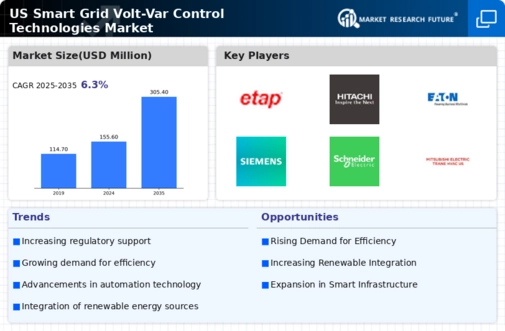Regulatory Support and Incentives
Regulatory support and incentives play a crucial role in shaping the Global US Smart Grid Volt-Var Control Technologies Market Industry. Government initiatives aimed at promoting smart grid technologies are fostering an environment conducive to innovation and investment. Policies that encourage utilities to adopt volt-var control solutions are likely to drive market growth. The projected compound annual growth rate of 8.28% from 2025 to 2035 indicates a strong commitment to enhancing grid efficiency and reliability. As utilities respond to regulatory pressures, the adoption of advanced technologies is expected to accelerate, further solidifying the market's trajectory.
Growing Demand for Energy Efficiency
The Global US Smart Grid Volt-Var Control Technologies Market Industry is experiencing a surge in demand for energy efficiency solutions. As energy consumption continues to rise, utilities are increasingly adopting volt-var control technologies to optimize voltage levels and reduce energy losses. This trend is driven by regulatory mandates and consumer expectations for sustainable practices. The market is projected to reach 12.5 USD Billion in 2024, reflecting a growing recognition of the importance of energy efficiency in grid management. Utilities are investing in advanced technologies to enhance grid reliability and performance, indicating a robust shift towards smarter energy management solutions.
Integration of Renewable Energy Sources
The integration of renewable energy sources into the grid is a pivotal driver for the Global US Smart Grid Volt-Var Control Technologies Market Industry. As the share of renewables in the energy mix increases, managing voltage and reactive power becomes critical. Volt-var control technologies facilitate this integration by ensuring grid stability and reliability. The anticipated growth of the market to 30 USD Billion by 2035 underscores the need for advanced control systems that can accommodate fluctuating energy outputs from solar and wind sources. This integration not only supports sustainability goals but also enhances the resilience of the energy infrastructure.
Rising Consumer Awareness and Engagement
Rising consumer awareness and engagement regarding energy usage are driving the Global US Smart Grid Volt-Var Control Technologies Market Industry. Consumers are increasingly seeking ways to reduce their energy bills and carbon footprints, prompting utilities to adopt technologies that facilitate demand response and energy management. This shift towards consumer-centric energy solutions is likely to enhance the adoption of volt-var control technologies. As the market evolves, utilities are recognizing the importance of engaging consumers in energy efficiency initiatives, which could further propel market growth in the coming years.
Technological Advancements in Control Systems
Technological advancements in control systems are significantly influencing the Global US Smart Grid Volt-Var Control Technologies Market Industry. Innovations in software and hardware are enabling more sophisticated voltage and reactive power management solutions. These advancements allow for real-time monitoring and control, enhancing grid performance and reliability. As utilities seek to modernize their infrastructure, the demand for advanced volt-var control technologies is expected to rise. The market's growth trajectory, reaching 12.5 USD Billion in 2024, reflects the increasing reliance on technology to optimize grid operations and meet evolving energy demands.














Leave a Comment